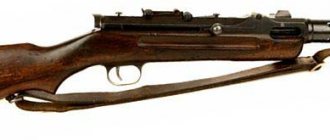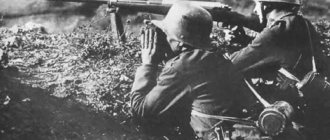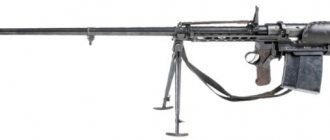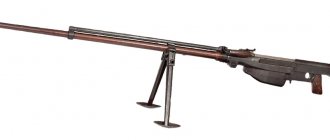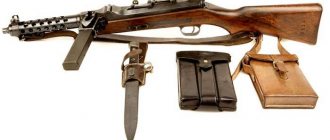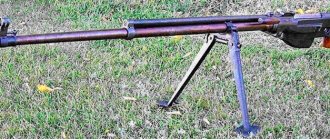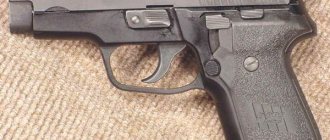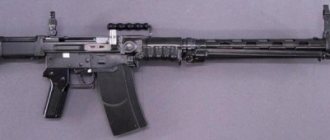Anti-tank rifle Solothurn S18-100, S18-1000 and S18-1100 (Switzerland)
Anti-tank rifle Solothurn S18-100.
Anti-tank rifle Solothurn S18-1100, which differed from the Solothurn S18-1000 in the possibility of automatic fire.
| Solothurn S18-100 | Solothurn S18-1000 | |
| Type | self-loading | |
| Caliber | 20x105B | 20x138B |
| Weight without cartridges | 40 kg | 51.7 kg |
| Length | 1760 mm | 2170 mm |
| Barrel length | 930 mm | 1447 mm |
| Magazine capacity | 10 rounds | 5 or 10 rounds |
| Armor penetration (Distance / Angle of contact / Penetration) | 100 m / 90o / 35 mm 300 m / 90o / 27 mm | 100 m / 90o / 40 mm 300 m / 90o / 35 mm |
The small Swiss arms company Solothurn Waffenfabrik AG suddenly entered the world arms markets at the very end of the 1920s, immediately after the company was acquired by the German military-industrial concern Rheinmetall Borsig AG. The Solothurn company was used by the Germans to develop and sell weapons to circumvent the restrictions imposed on Germany by the terms of the 1918 Treaty of Versailles. One of the German developments that was published in the early 1930s under the Swiss “roof” was the 20mm Solothurn S18-100 anti-tank rifle, based on the developments of Rheinmetall designer Louis Stange. Anti-tank rifles of this model had limited commercial success; they were purchased in small quantities by, among other places, Hungary and Finland. In the mid-1930s, Solothurn engineers decided to increase the effectiveness of this weapon by redesigning the anti-tank gun to accept more powerful 20mm shells from the German FlaK 30 and FlaK 38 anti-aircraft guns developed by Rheinmetall. The new anti-tank rifle received the index Solothurn S18-1000, and on its basis the “universal gun” Solothurn S18-1100 was soon created, which allowed the possibility of firing in bursts and in this version was suitable for use as an anti-aircraft gun (from special machines). Solothurn S18-1000 anti-tank rifles were purchased from Italy, Holland, and Switzerland. In the German army, the Solothurn S18-1000 anti-tank rifle had the index PzB-41(s). It was an impressive weapon, but its effectiveness against Allied tanks of the 1942 model and later was already relatively low. However, due to the availability of a wide range of types of ammunition, in addition to armor-piercing (high-explosive fragmentation, incendiary, etc.), the Solothurn S18-1000 anti-tank rifles could also be used as a weapon for direct infantry support.
The Solothurn S18-100 anti-tank rifle uses an automatic weapon with a movable barrel that has a short recoil stroke. The barrel is locked (coupling the barrel with the bolt) using a rotary coupling placed on the breech of the barrel. On the inner surface of the coupling there are grooves that engage with the bolt lugs. When the barrel rolls back, shaped grooves in the receiver rotate this clutch, disengaging it from the bolt. Firing is carried out only in single shots, from a closed bolt. Ammunition is fed from detachable box magazines attached horizontally to the left. The barrel is equipped with a muzzle brake to reduce felt recoil. Shooting is carried out from a support, using a bipod mounted in the front of the receiver, and an additional adjustable support under the butt. The sight is adjustable, with range settings from 100 to 1500 meters, it is also possible to install an optical sight.
The Solothurn S18-1000 anti-tank rifle generally repeated the design of its predecessor, but was larger in size and had a more effective muzzle brake on the barrel.
Submachine gun "Tallinn Arsenal"
It was tiny Estonia that received the dubious fate of becoming the first country in the world where a shootout with submachine guns took place.
So: the effectiveness of the new type of weapon very impressed the Estonian military - and even in neighboring Finland they were surprised. But, alas, if rifles on the arms market after the First World War were like dirt, and you could get hold of machine guns at a reasonable price, then with submachine guns the situation was worse. Thompsons in the USA cost as much as a third of a new Ford. The release of the German Maschinenpistole 18.I was launched with minor changes by the Swiss from the company SIG (Model 1920, also known as Brevet Bergmann), but the Swiss price tags seemed too high to the Estonians.
The logical result was the decision to “raise Baba Yaga in our team” - that is, to engage in independent production of such weapons.
The design, or more precisely, the adaptation of the German submachine gun to the capabilities of local industry, was undertaken by Johannse Theiman. It is interesting that the Estonian version was chambered for 9×20 Browning Long cartridges, since the army already had Browning M1903 pistols chambered for it. For Soviet readers, Vladimir Bogomolov described this cartridge and pistol as a weapon of German special agents very colorfully.
Otherwise, the Estonian Tallinn Arsenal were very similar to their ancestor. The weapon was equipped with a box magazine for 40 rounds, the sight was designed for 600 meters.
Tallinn Arsenal (photo source)
Total production was approximately 570, mostly going to the Border Guard. When in the 30s Estonia decided to purchase more promising Suomi from its neighbors, part of the Tallinn arsenals was sold to other neighbors - the Latvians. Well, some of them even found their way into Republican Spain through unknown means. A couple of “arsenals” preserved there were acquired in our time by an Estonian officer, thus returning part of its historical heritage to the recreated republic.
Of particular interest is the assessment of the Estonian project by Soviet designers. After 1940, along with a number of other systems, a submachine gun, called “Esti” in the documents, ended up at the GAU KA shooting range. Although it was absolutely correctly assessed as a model made based on the MP-18, the test site specialists considered it necessary to draw the attention of gunsmiths to a number of Estonian decisions. “The Esti submachine gun has the simplest design and most reliable trigger mechanism.
Brenson submachine gun
While little is known about Estonian submachine guns, almost no one knows about the machine gun from neighboring Latvia. Meanwhile, back in 1925, engineer of the 4th Infantry Regiment Alexander Branson developed his original version of a light machine gun chambered for the English .303 cartridge, which was then used by the army of the independent Republic of Latvia.
Branson-designed submachine gun (photo source)
The external similarity of this weapon with the famous Czech ZB, which appeared a year later, gave some Latvian historians reason to assume that it was the Branson machine gun that became the prototype for the Zb-26, which later became the British Bren.
In Latvia itself, only a photocopy of one of the technical drawings remained of the product, but in the Central Archive of the Ministry of Defense of the Russian Federation there is a test report on the “7.71-mm light machine gun of the ARS brand, received from the Riga Artillery Arsenal.”
Soviet gunsmiths, having discovered an “animal unknown to science” among the motley weapons of the new Soviet republic, treated it with all due seriousness. The machine gun was sent to Moscow, and in 1941 it went through a full cycle of tests at a shooting range. Based on the results, the following conclusion was made: “The 7.71-mm ARS light machine gun is inferior in its most important combat properties to the domestic DP machine gun, but in individual components and parts it has some design advantages.”
Submachine gun Steyr-Solothurn S1-100
The Steyr-Solothurn S1-100 Rheinmetall MP 19 submachine gun of the Louis Stange system. It was produced in Austria and Switzerland and was widely offered for export. The S1-100 is often described as one of the best submachine guns of the interwar period.
History of creation and production
After World War I, the production of submachine guns like the MP 18.I was banned in Germany. However, in violation of the Treaties of Versailles, a number of experimental submachine guns were secretly developed, among which was the MP 19 Rheinmetall-Borsig .
To circumvent post-war restrictions, Rheinmetall in 1929 absorbed the Swiss company Waffenfabrik Solothurn AG , whose task was to develop, produce and sell a new submachine gun on the foreign market. However, its production capacity was not enough, so it was decided to use a subcontractor in the person of the Austrian concern Steyr-Daimler-Puch AG , the largest weapons manufacturer in Europe.
Rheinmetall MP 19 submachine gun
Production of the serial version under the name Steyr-Solothurn S1-100 began in 1930 and continued until the end of 1940. On the world market, the submachine gun was sold on behalf of the joint company Steyr-Solothurn Waffen AG , headquartered in Zurich. The production itself was located mainly in Austria.
The main buyers of the Steyr-Solothurn S-100 were Chile, El Salvador, Bolivia and Uruguay, and it was used in the Gran Chaco War. In 1935, Portugal purchased and adopted submachine guns under the symbol m/935 in 7.65x21 mm Parabellum caliber. Japan and China made limited use of the 7.63x25mm Mauser variant throughout World War II.
Steyr-Daimler-Puch AG concern also produced this submachine gun for Austria, where it was in service with the police and gendarmerie as the Steyr M.30 in 9x23 mm Steyr caliber. The Steyr M.34 chambered for the 9×25 mm Mauser Export cartridge was produced for the Austrian army
The Steyr M.34 became the first foreign submachine gun to enter service with the Wehrmacht, police and SS troops. After the Anschluss of Austria, the Germans included it in the Wehrmacht standard weapons system under the designation MP.34(ö) . For those produced in 1938–1940. MP.34(ö) submachine guns were marked with the code assigned by the Germans to Steyr-Daimler-Puch - 660 . During the war, this submachine gun was widely used by the police, SS troops, and ground units of the Luftwaffe.
In 1942, the Portuguese purchased another batch of Steyr-Solothurn submachine guns from Switzerland, but this time chambered for the 9-mm Parabellum cartridge. He received the index m/942 .
Design and principle of operation
The Steyr-Solothurn S1-100 automatic system operates on the principle of free-breech recoil with a stationary barrel. Firing is carried out in single shots and bursts; the fire type translator in the form of a slider is located on the stock on the left. The engine moves along a steel bar embedded in the forend and secured with two screws. When the engine is moved forward all the way, the trigger mechanism is set to the position for continuous fire. “O” opens on the bar . To fire a single fire, the engine is moved back all the way, and the letter “E” .
Unlike most analogues, the bolt return spring is not located in the receiver, but in the butt channel, and is connected to the bolt by a long pusher rod.
The receiver has a lid that flips up and down, making disassembling the weapon for cleaning and maintenance very simple and convenient. The outside of the cover is milled in the form of several longitudinal edges. The lower half of the receiver and the cylindrical barrel housing are a single piece. The internal surfaces in contact with the bolt are chrome-plated; the outside of these parts, as well as the barrel casing, are polished and chemically oxidized.
